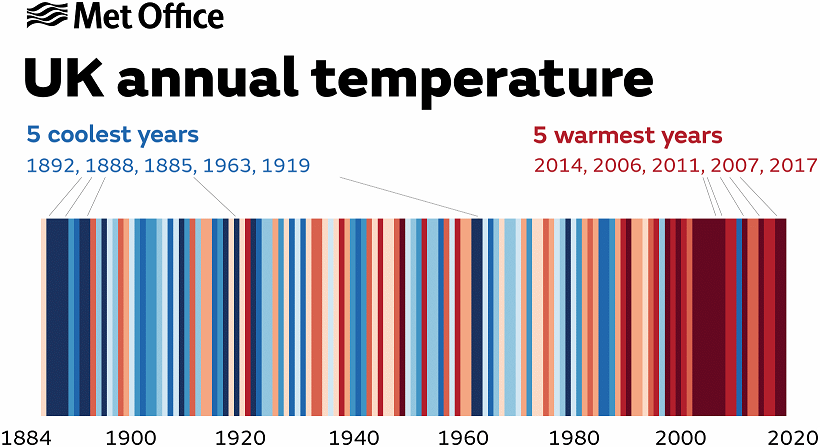Introduction
Scientific context

Changes to UK annual mean temperatures 1884 to 2020. Source: Met Office, "What is Climate Change?"
IPCC projections indicate that global temperature increases will lead to more frequent and more extreme heatwaves, droughts, precipitation and storms. While these changes are now unavoidable, their severity depends on how far global temperatures rise and therefore the speed of reduction of greenhouse gas emissions.
Gosport Borough Council recognises that it has a responsibility both to adapt to climate change and to contribute to the local, national, and global effort to reduce greenhouse gas emissions with innovation and technology being key to those efforts.
Policy context
Central policy drives the ambition, with the Climate Change Act 20083 defining a legally binding target for the UK to reach net-zero emissions by 2050, underpinned by the Government's Net Zero Strategy, which sets out policies to achieve this target and an interim target of a 78% cut in emissions by 20354.
Local authorities will deliver many of these policies and most have committed to achieving net-zero emissions by 2050, or earlier. Hampshire County Council has set a target of reaching net-zero emissions across Hampshire by 2050, and is collaborating with local Councils, including Gosport, to implement measures to achieve this.
Gosport Borough Council passed a resolution in 2020 to acknowledge climate change and the need for action: to embed work to address climate change in all service areas, reduce emissions from Council operations, establish a Climate Change Partnership, work in partnership across the Borough, county and region, engage with residents (especially with young people), and call on the UK Government to provide the powers and resources to make this possible.
Local context
Gosport's location, demography and built environment will influence its approach towards and resilience to Climate Change. A profile of the Borough is available here.
Gosport is predominantly urban in character with a population density nine times the England average. The over 65 year old population is projected to increase from 21% (2021) to 28.5% (2038).
Based on average ranking of Indices of Multiple Deprivation for neighbourhoods within each local authority area, Gosport is the most deprived local authority area in Hampshire, and the 130th most deprived out of 317 areas in England.
There are 0.52 jobs per working-age resident, the 13th lowest figure in the UK, resulting in high levels of out-commuting. Gosport is one of the largest towns in England with no rail service, although the Gosport Ferry provides access to Portsmouth and a train station. The Bus Rapid Transit runs frequent buses between Gosport and Fareham although bus services outside this route are more limited.
This coastal Borough's land is flat and low-lying, which provides opportunities for cycling and walking but also risk of flooding: 14% of the land is classed as vulnerable to flooding, and this is predicted to increase as shown below.

Current and projected areas at risk of flooding. Source: Interim Strategic Flood Risk Assessment for Gosport Borough Local Plan 2038(PDF)[162KB](opens new window).
← Previous section Next section →
Notes
- ⇧ See the IPCC Sixth Assessment Working Group 1 Report for more information.
- ⇧ See the Met Office UK Climate Projections for more information.
- ⇧ As amended in 2019.
- ⇧ Compared to 1990 figures and approved by Parliament in 2021.




